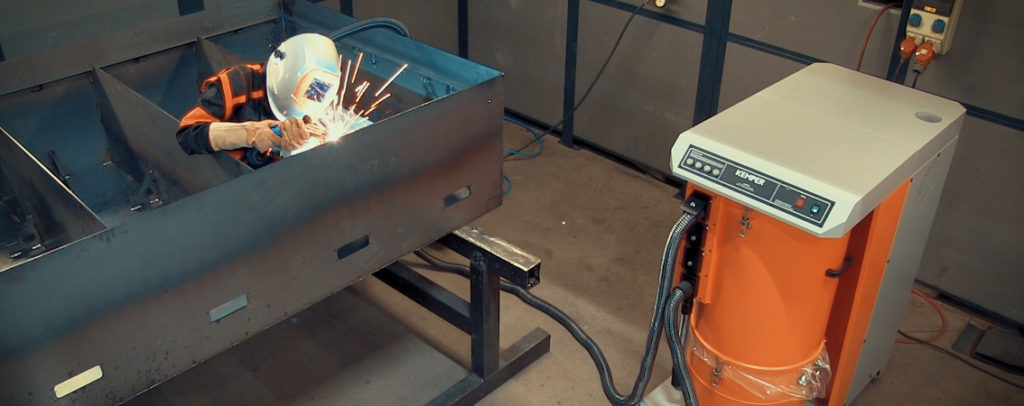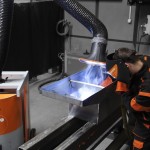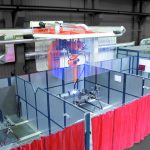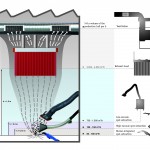Optimum air volume flow at the welding torch: How current standardisation regulates torch extraction
To make torch extraction efficient, the precise adjustment of individual parameters is necessary. Most recently, the French Institute for Occupational Safety INRS drew attention to the subject with its investigations into torch-integrated welding fume extraction. The findings are currently being incorporated in a new DIN standard for torch extraction.
Many different versions of torch extraction systems are already available on the welding technology market. Various manufacturers have already dealt with this topic, but when developing their own extraction torch, the manufacturers always followed their own requirements. They differed in the following points among others:
- Maximum welding currents
- Shape and position of the extraction openings
- Required volume flows for extraction
- Flow resistances in the hand grip and hose package
Depending on the model, for example, the volume flows to be extracted vary between 50 and 150 cubic metres of air per hour. There were no general requirements for optimum welding fume extraction by means of extraction torches until now.
International standardisation for torch extraction
The question of how the extraction rate – or the efficiency – of an extraction torch can be measured was addressed by an international working group in order to set up a new standardisation process (ISO TC44 SC9 WG4). Due to the diversity of the systems, it was difficult to provide advice because it was difficult to agree on important parameters such as
- Welding seam position
- Voltage and amperage
- Wire diameter and feed rate
- Angle of use of the torch
- Short circuit arc or spray arc
- Volume flow of the protective gas
- Volume flow of the extraction
- Required vacuum for extraction
In 2016, the standard series DIN EN ISO 15012 “Health and safety in welding and allied processes – Requirements, testing and marking of equipment for air filtration” was published as Part 3 “Determination of the capture efficiency of on-torch welding fume extraction devices” (DIN EN ISO 21904-3:2018-07 published by Beuth-Verlag). This standard only describes a measurement procedure, however, and does not define any requirements for such systems.
 Specific requirements for torch extraction by INRS
Specific requirements for torch extraction by INRS
It then became much more specific thanks to the French Institute for Occupational Safety (IRNS). In extensive measurement series, it demonstrated the direct correlation between the arrangement of the extraction openings, the volume flow used at this point and the extraction rate achieved as a result. As a fixed point for extraction, it chose a distance of 20 millimetres in front of the gas nozzle. The greater the air velocity generated by the extraction at this point, the higher the extraction rate.
There is a risk, however, that the protective gas will be impaired by too high an air volume flow. In addition, the influence of the angle of use of the welding torch was also investigated as part of the research at INRS: A steep angle is better for good capture during torch extraction than a flat angle. At a flatter angle, part of the welding fumes are also blown to the side by the protective gas flow and no longer included in the extraction. INRS also investigated how high the air velocity may be due to extraction at the point of welding without endangering the protective gas envelope.
This is how KEMPER came up with the development of a new torch extraction
The French findings were also so important internationally that they are now being incorporated in a new international standard. To this end, DIN EN ISO 15012 “Health and safety in welding and allied processes – Requirements, testing and marking of equipment for air filtration” is currently being revised as Part 1 – and, in fact, could even be updated this year. This increases the relevance of the measurements for other countries as well. According to the current state of the art, the following are prescribed by the ISO standard:
- Manufacturers of systems for torch extraction should provide information in the documentation on the volume flows at the extraction nozzle and connector, extraction capacities and the vacuums available for this. This means that the operator should be able to identify which device fits which extraction torch under which conditions.
- The documentation from the manufacturer of systems for torch extraction must provide instructions for their correct use.
- It is recommended to construct the torch extraction in such a way that it is not possible to weld without an extraction device installed.
The requirements on the French market meant that welding torch manufacturers wanted to know which volume flows were optimum for their products. This is how the extraction specialist KEMPER came into play…
In the next part of our short series on torch extraction you can read how KEMPER developed a unique torch database and a new generation of pistol extraction.





